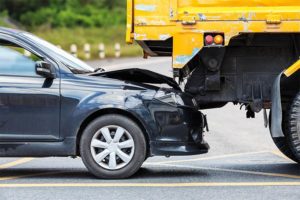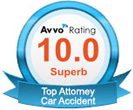
Underride truck accidents, also sometimes called run under crashes, can be extremely dangerous often causing fatal or catastrophic injuries. In an underride truck accident, a car or other smaller vehicle collides with the trailer of a semi or other large truck. Momentum moves it under the truck often causing it’s top to be ripped off and terrible injuries to the smaller vehicle’s occupants. In some underride crashes the car can become pinned under the big truck and dragged resulting even more serious injury. Experienced underride accident lawyers will likely be familiar with how this can happen.
In a typical crash involving two cars or smaller vehicles the heights of the vehicles are usually somewhat matched reducing or eliminating the potential for kinds of catastrophic injuries seen in an underride truck accident. In a crash involving a car and semi or other big truck, the heights of the vehicles are often dangerously mismatched. Semis usually have much taller tires than passenger cars. The bottom of the semi’s trailer or straight truck’s cargo area usually sits much higher than the floor of cars or other smaller vehicles on the road. This mismatch creates the conditions for the horrible injuries and deaths which often happen in an accident.
Side underrides and rear underrides are the most common underride accidents. Other common truck accident types include head on, jackknife accidents and rollover accidents.
Side Underride Truck Accident
Semis accelerate slower and require more space to maneuver and turn than most small passenger vehicles. They have a big open area under the trailer between the tractor’s back wheels and the trailer’s front wheels. This area is tellingly sometimes called the “kill zone”. Large straight trucks may also have a similar but smaller open area.
When the open space under the trailer is in the path of oncoming traffic the potential for a side underride truck accident exists. In a side underride truck accident, the open area beneath the trailer or truck body is in the way of an oncoming traffic. Forward inertia can propel the other car or other smaller vehicle underneath the truck often causing the top of the smaller vehicle to be torn off or severely damaged resulting in terrible injuries to the people in the passenger vehicle or a fatal truck crash. Intersections are a common location for a side underride 18 wheeler accident. They happen in a number of ways.
Left Turns. A semi or other big truck making a left turn creates the potential for a side underride accident. A loaded semi can take 15 seconds or more to safely complete a left turn from start to finish. If the truck driver turns left but can’t safely complete the turn and clear the intersection without interfering with vehicles coming from the other direction, the trailer may be in the path of oncoming traffic. A car or other smaller vehicle coming from the other direction may collide with the trailer and end up under the trailer’s side in a side underride truck crash.
To reduce left turn truck crashes including side underride accidents truck drivers are taught to wait until they are in the center of the intersection before beginning to turn left. Some trucking companies also encourage their drivers to minimize or avoid left turns.
Right Turns. Right turns are another situation which can result in a side underride truck wreck. Semi drivers are taught to keep the truck close to the right curb when making a right turn. They are instructed to move into the intersection and begin the right turn directly into the other street in what is called a “button hook” turn. Moving the truck to left and beginning their turn on the road they are on is called a “jug handle” turn is considered improper and dangerous. A jug handle right turn can leave open space between the truck and the curb allowing other vehicles to come up on the right side of the truck. They can be cut off as the truck turns in front of them. This is called a “right turn squeeze” and is one of the situations which can result in a truck wreck.
Other Situations. Some other situations in which a side underride truck accident can happen include crossing or blocking an intersection, backing up on the traveled part of the road, U-turns, night time or other low light situations, bad weather and congested traffic.
Rear Underride Truck Accident
 In some ways a rear underride truck accident is the opposite of a typical rear end crash. In the usual rear end truck crash a semi or other big truck crashes into the rear of your vehicle. In a rear underride truck crash the car rear ends a semi or other big truck. The higher clearance under the truck compared to cars or other smaller vehicles creates the space for those vehicles to be propelled under the truck. The edge of the trailer or cargo box on a straight truck then can act as shear tearing off the top part of the car and catastrophically injuring its occupants.
In some ways a rear underride truck accident is the opposite of a typical rear end crash. In the usual rear end truck crash a semi or other big truck crashes into the rear of your vehicle. In a rear underride truck crash the car rear ends a semi or other big truck. The higher clearance under the truck compared to cars or other smaller vehicles creates the space for those vehicles to be propelled under the truck. The edge of the trailer or cargo box on a straight truck then can act as shear tearing off the top part of the car and catastrophically injuring its occupants.
In one study the National Highway Traffic Safety Administration (NHTSA) found that more than 90% of rear underride truck accidents involved situations where the 18 wheeler or other big truck was either stopped or moving 5 miles per hour or less. In the same study the average speed of the vehicle colliding with the big truck was approximately 60 miles per hour. It’s easy to understand how a fast-moving car or other smaller vehicle crashing into the back of a big, heavy semi or other large truck which is stopped or moving slowly could cause a wreck involving major force and causing terrible injuries. The height mismatch between the big truck and smaller vehicle dramatically increases the danger and injury potential.
Certain things increase the danger of rear underride truck accidents. One is where an 18-wheeler or other big truck is parked on a highway shoulder or ramp. Most of us have seen this as we travel on the roads. The danger arises when a car or other smaller vehicle traveling at highway speed goes off the road and collides with the rear of the truck. This can be caused by factor like the car being rear-ended by another vehicle, mechanical problems, driver fatigue or distraction and other causes. The trucking industry has been very aware of the danger for a long time. They even have a name for trucks parked like this. They call them “sitting ducks”. Some states or localities outlaw parking on the shoulder or ramps.
An example of a tragic crash like this happened in October, 2020 on Interstate 435 in the Kansas City area. In the dark early morning hours, a car reportedly reduced speed for emergency personnel and was rear-ended by a semi on the highway. The car was then apparently propelled into the rear of another semi parked on the shoulder of the highway. Video depicting the car after it was forced into the back of the semi shows that the car was essentially destroyed in a way consistent with the type of damage an underride truck accident can cause. News reports indicate that both occupants of the car sustained serious injury.
Another danger from parking on highway shoulders comes the fact that an 80,000 lb. big rig doesn’t accelerate as quickly as the typical car. It takes more time and distance to get up to highway speed. When the truck attempts to merge back into highway traffic at first it is likely to be going much slower than other traffic on the road. This creates danger for other vehicles on the road traveling at highway speed because they may not be able to slow down in time to avoid crashing into the back of the truck which is trying to merge into traffic at the much slower speed.
Our firm lawyer handled a case involving a situation like this. A semi was parked on the shoulder of the Kansas Turnpike on an uphill grade at night in the dark. This was both dangerous and illegal. Because loaded semis take longer to get up to speed it was moving slower than other traffic as it merged back onto the highway. The truck was rear-ended by another 18 wheeler which created a traffic hazard on at night on the dark high-speed road. A catastrophic rear underride truck accident could have easily happened if a car or other smaller vehicle had rear ended the slow moving semi instead of another 18 wheeler. A third semi was in the vicinity. It tried to avoid the situation but also became involved resulting in a crash involving 3 semis. This required closing of the southbound lanes of the Kansas Turnpike in the vicinity of the crash and a detailed investigation and accident reconstruction by the Kansas Highway Patrol to determine exactly how the crash happened.
Trailer Swing Rear Offset Underride
A form of underride called a rear offset underride can be caused by a phenomenon called “trailer swing”. In certain conditions the trailer of a semi truck can loose traction and slide at an angle to the cab instead of moving forward in the direction the tractor is going. This is called “trailer swing”. Bad road conditions like those caused by ice and snow reduce traction and increase the risk of a trailer swing.
The rear corner of the trailer can suddenly and unexpectedly go into the adjacent traffic lane. If there is a vehicle in that lane, close to where the trailer swings, the trailer can seem to appear in front of the vehicle for no reason. If the vehicle in front of which the trailer swings is close enough it may collide with the rear corner of the trailer and move under it. This is called rear offset underride. Like other underride crashes it can cause catastrophic or fatal injuries. Because the cause of these crashes may not be immediately to people not familiar with how this type crash happens may not assign fault for the crash properly.
Underride Truck Accident Prevention
Both the trucking industry and federal regulators have been aware for a long time of the extreme danger that an underride truck accident presents. Primary safety measures to avoid these include underride guards, making the truck more easily seen, safety regulations and driver training. Tragically, these steps are inadequate to eliminate the danger of underride truck accidents and hundreds of people continue to be killed or seriously injured each year in an underride truck accident.
Underride Guards
As you travel you may have seen trucks with bars on the rear. This is often called a rear impact guard, “ICC bumper” or “Mansfield bar” after Jane Mansfield the famous actress died in an underride trucking accident. The purpose of these is to prevent a rear underride truck accident by stopping cars and other smaller vehicles which collide with the back of a truck or trailer from going under the truck. While these can be somewhat effective in certain situations, they are an incomplete solution, not adequate in high speed crashes and people continue to be killed and seriously injured in rear underride truck accidents. As of May, 2021 the US government is considering requiring better underride guards but new laws or regulations requiring have not been put in place.
The situation concerning a side underride accident is worse. Most semi-trailers have no guards or protection against a side underride truck accident. What you will see on many semi trailers is simply a big open space. Some have panels which cover the area. These are called “trailer skirts” or “air skirts” and are designed to improve fuel economy but do not provide significant protection against underrides. Side underride guards which help reduce the severity of side underride truck accidents are available. As of this writing they are not legally required.
Conspicuity-Making the Truck Easier to See
Nighttime darkness, weather conditions like fog, rain or falling snow or other low light situations can reduce visibility, make a truck harder to see and increase the risk of an underride truck accident. Conspicuity is a big word for making something conspicuous or easier to see. In the case of semis and other big trucks the Federal Motor Carrier Safety Regulations (often called FMCSRs) require two different methods- lights and reflectors. One purpose of these is to help other drivers on the road see the truck so they can try to avoid colliding into it.
The FMCSRs have specific detailed rules for the type, location and number of lights on commercial vehicles. Lights can stop working or not function properly. Vibration, corrosion, breakage, damage from weather conditions, salt, road debris and other conditions can cause them to burn out, dim or otherwise not work right. Wiring, switches and connectors can malfunction or fail. In extreme situations the truck’s electrical system can stop working causing a loss of electrical power. Accordingly, the FMCSRs also have requirements for reflective tape and/or reflectors on trucks.
How Dangerous is an Underride Truck Accident?
One word- Extremely. It’s easy to see the potential for death and serious or catastrophic injury where a regular vehicle is propelled under an 80,000 lb. semi or other large truck.
Unfortunately, this kind of disaster happens more often than we think. The National Highway Traffic Safety Administration (NHTSA) studied truck underride accidents in the US over a one-year period (2008-2009). Within that period light vehicle rear-end underrides caused 724 deaths and 286 injuries. Side underride truck accidents have similarly devastating potential.
As the above data indicates, fatalities are very common in underride truck accidents. And when they don’t cause death, they often cause life-altering injuries. These include dismemberment or amputation, spinal cord injuries, traumatic brain injuries, damage to bodily organs, and substantial disfigurement.
These injuries bring physical as well as financial burdens. Victims and their families rack up mountains of medical bills, rehabilitation costs, and long-term care costs. Along with these are the emotional distress and the significant changes in the everyday lives of those involved.
The law generally entitles accident victims to compensation if their injuries were caused by another party’s negligence. Ideally, injured individuals and distressed families should not have to suffer more to recover what they are entitled to. But the sad reality is that obtaining compensation for truck underride injuries can be much more complicated than the typical car crash claim.
Catastrophic injuries from an underride truck crash can result in huge hospital bills, future medical expenses, lost income and other losses. Further, getting compensation requires a solid knowledge of truck accident law. If you or a loved one has suffered from this type of truck accident, contact an experienced, skilled attorney. In the Kansas and Missouri, reach out to us at the Flick Law Firm. We provide effective legal services to individuals and families who have been seriously injured in an accident with a truck or another large commercial vehicle.
Don’t Delay – Contact Us Today
Missouri and Kansas both have statutes of limitations on truck accident injury and death claims. In Missouri, you may have only five years to file a lawsuit for personal injury and three years to file one for wrongful death. In Kansas, you may have only two years. Other deadlines exist so it’s best to check with a knowledgeable attorney about how long you have. It may seem like you have a long time to pursue your compensation claim, but too many accident victims have lost their right to sue because they put it off for too long. Further, important evidence can be lost or destroyed with the passage of time so it is important to act immediately.
After your underride accident, rear-end accident, jackknife accident, rollover accident or any other kind of truck accident, it may be hard to think about lawsuits right away. However, it is best to at least consult with a lawyer as soon as you can, if only to learn about your legal options.
Your initial consultation with us at the Flick Law Firm is absolutely free and confidential. You won’t be charged any lawyer fees until we obtain your compensation for you. Call us today at (816) 221-0501 or simply fill out our Contact Us Form. We look forward to helping you.










